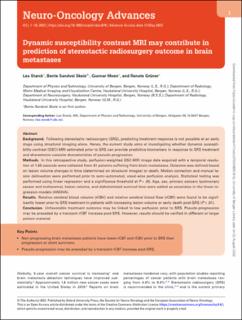| dc.contributor.author | Starck, Lea | |
| dc.contributor.author | Skeie, Bente Sandvei | |
| dc.contributor.author | Moen, Gunnar | |
| dc.contributor.author | Grüner, Renate | |
| dc.date.accessioned | 2022-08-03T13:17:32Z | |
| dc.date.available | 2022-08-03T13:17:32Z | |
| dc.date.created | 2022-05-16T15:44:01Z | |
| dc.date.issued | 2022 | |
| dc.identifier.issn | 2632-2498 | |
| dc.identifier.uri | https://hdl.handle.net/11250/3009999 | |
| dc.description.abstract | Background
Following stereotactic radiosurgery (SRS), predicting treatment response is not possible at an early stage using structural imaging alone. Hence, the current study aims at investigating whether dynamic susceptibility contrast (DSC)-MRI estimated prior to SRS can provide predictive biomarkers in response to SRS treatment and characterize vascular characteristics of pseudo-progression.
Methods
In this retrospective study, perfusion-weighted DSC-MRI image data acquired with a temporal resolution of 1.45 seconds were collected from 41 patients suffering from brain metastases. Outcome was defined based on lesion volume changes in time (determined on structural images) or death. Motion correction and manual lesion delineation were performed prior to semi-automated, voxel-wise perfusion analysis. Statistical testing was performed using linear regression and a significance threshold at P = .05. Age, sex, primary cancers (pulmonary cancer and melanoma), lesion volume, and dichotomized survival time were added as covariates in the linear regression models (ANOVA).
Results
Relative cerebral blood volume (rCBV) and relative cerebral blood flow (rCBF) were found to be significantly lower prior to SRS treatment in patients with increasing lesion volume or early death post-SRS (P ≤ .01).
Conclusion
Unfavorable treatment outcome may be linked to low perfusion prior to SRS. Pseudo-progression may be preceded by a transient rCBF increase post-SRS. However, results should be verified in different or larger patient material. | en_US |
| dc.language.iso | eng | en_US |
| dc.publisher | Oxford University Press | en_US |
| dc.rights | Navngivelse 4.0 Internasjonal | * |
| dc.rights.uri | http://creativecommons.org/licenses/by/4.0/deed.no | * |
| dc.title | Dynamic Susceptibility Contrast MRI May Contribute in Prediction of Stereotactic Radiosurgery Outcome in Brain Metastases | en_US |
| dc.type | Journal article | en_US |
| dc.type | Peer reviewed | en_US |
| dc.description.version | publishedVersion | en_US |
| dc.rights.holder | Copyright 2022 The Author(s) | en_US |
| dc.source.articlenumber | vdac070 | en_US |
| cristin.ispublished | true | |
| cristin.fulltext | original | |
| cristin.qualitycode | 1 | |
| dc.identifier.doi | https://doi.org/10.1093/noajnl/vdac070 | |
| dc.identifier.cristin | 2024949 | |
| dc.source.journal | Neuro-Oncology Advances (NOA) | en_US |
| dc.identifier.citation | Neuro-Oncology Advances (NOA). 2022, 4 (1), vdac070. | en_US |
| dc.source.volume | 4 | en_US |
| dc.source.issue | 1 | en_US |

